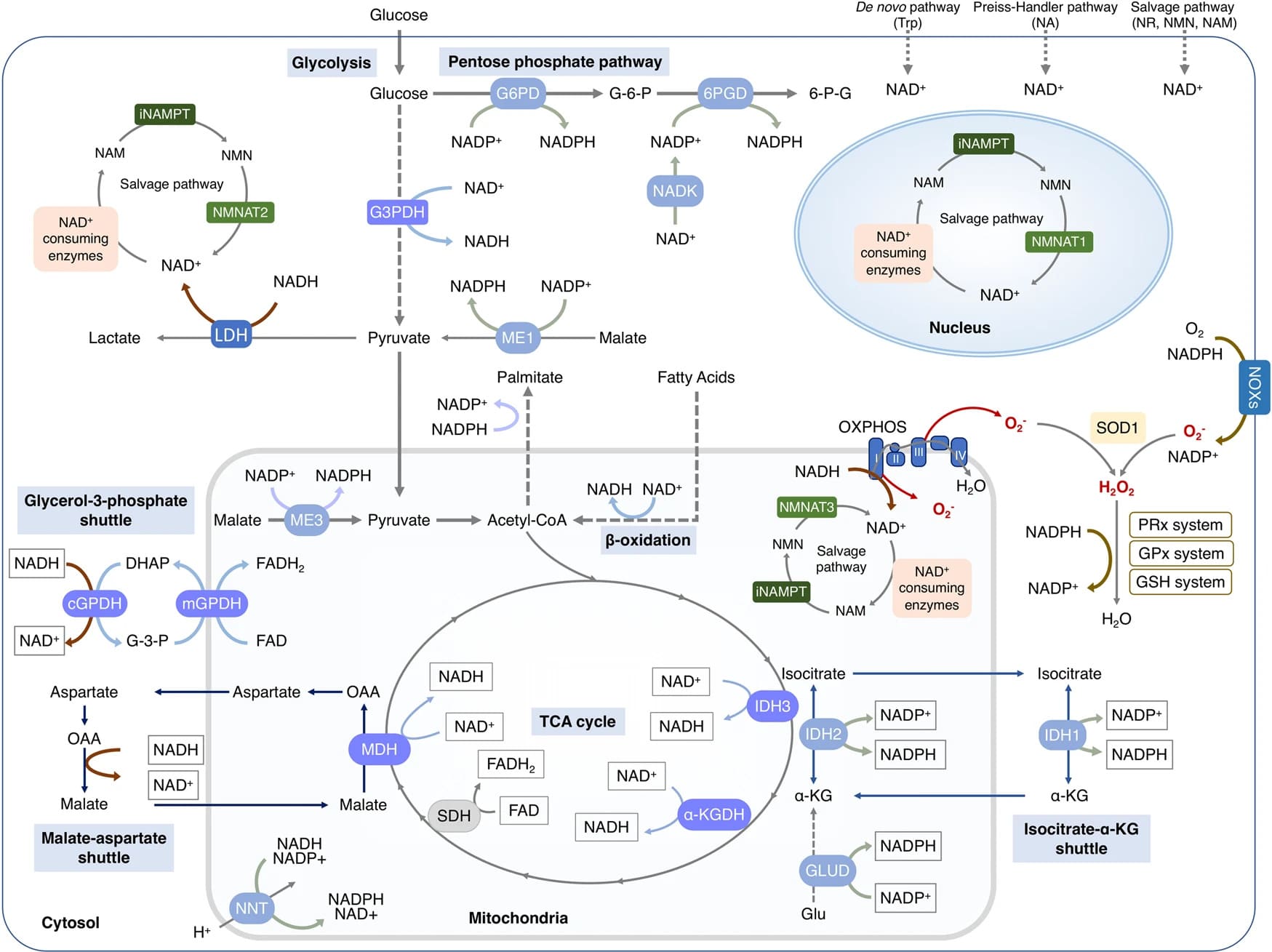
Welcome to our comprehensive guide on Nicotinamide Adenine Dinucleotide (NAD+), a pivotal molecule at the heart of cellular metabolism and longevity. This article delves into the multifaceted roles of NAD+ in energy production, DNA repair, and aging processes, along with a detailed exploration of natural dietary sources and advanced metabolite analysis techniques. Our focus is to provide you with in-depth knowledge and practical insights into how NAD+ impacts health and how its levels can be optimized through diet and scientific analysis.
Nicotinamide Adenine Dinucleotide, commonly known as NAD+, is a fundamental molecule found in every living cell. This vital coenzyme plays a crucial role in the bioenergetic and metabolic processes that fuel cell life. NAD+ is composed of two nucleotides: nicotinamide mononucleotide (NMN) and adenosine diphosphate (ADP), which are connected through a distinctive pyrophosphate bond.
In the energetic dance of cellular activities, NAD+ stands out as a versatile performer, seamlessly transitioning between its oxidized form (NAD+) and its reduced form (NADH). This transformation is central to the redox reactions that NAD+ participates in, underscoring its role as an essential electron transporter. By shuttling electrons from one molecule to another, NAD+ enables the critical processes of energy metabolism, aids in the intricate repair mechanisms of DNA, and plays a pivotal role in cell signaling.
Understanding the multifaceted nature of NAD+ sheds light on its importance in maintaining cellular health and vitality. As a linchpin in energy production and systemic regulation, NAD+ influences a wide array of bodily functions, making it a key target for nutritional and therapeutic interventions. Its universal presence and multifunctional capabilities make nicotinamide adenine dinucleotide a molecule of immense interest in the realms of health, wellness, and disease prevention.
_(VanLinden_et._al_2015)..jpg) In the realm of cellular biochemistry, the molecules NAD+, NADH, and NADP+ play critical roles in maintaining cellular functions and energy metabolism. These coenzymes are pivotal in various biochemical pathways, each serving distinct functions that are indispensable for the health and operation of cells.
In the realm of cellular biochemistry, the molecules NAD+, NADH, and NADP+ play critical roles in maintaining cellular functions and energy metabolism. These coenzymes are pivotal in various biochemical pathways, each serving distinct functions that are indispensable for the health and operation of cells.
NAD+ (nicotinamide adenine dinucleotide) is primarily involved in oxidative reactions, serving as an essential electron carrier. It plays a central role in catabolic reactions such as glycolysis and the citric acid cycle. In these processes, NAD+ accepts electrons, transitioning into its reduced form, NADH. This conversion is a critical step, as NADH subsequently donates these electrons to the electron transport chain, leading to the generation of ATP, the primary energy currency of the cell.
On the other hand, NADP+ (nicotinamide adenine dinucleotide phosphate) bears an additional phosphate group compared to NAD+. This structural difference is significant, conferring NADP+ with unique roles predominantly in anabolic reactions, such as the synthesis of fatty acids and nucleotides. In these pathways, NADP+ functions as a reducing agent, offering the electrons required for the biosynthesis of complex molecules from simpler precursors.
The distinctions between NAD+, NADH, and NADP+ are not merely structural but are indicative of their diverse roles within cellular biochemistry. These coenzymes are fundamental to the metabolic processes that sustain life, and their study offers significant insights into cellular function, energy metabolism, and the pathological mechanisms underlying various diseases.
The nexus between NAD+, aging, and longevity is a burgeoning area of scientific inquiry that has captured the attention of the biogerontology community. As our understanding deepens, NAD+ is increasingly recognized not merely as a metabolic molecule, but as a pivotal factor influencing aging and lifespan.
Research has shown that NAD+ levels decline with age, a phenomenon that is closely associated with a range of age-related diseases, including neurodegenerative disorders, cardiovascular diseases, and metabolic dysfunctions. The decline in NAD+ impacts cellular functions across multiple fronts, notably in energy metabolism, DNA repair, and genomic stability, which are all critical processes implicated in aging.
The link between NAD+ and longevity is underpinned by its role in sirtuin activation. Sirtuins are a family of proteins that require NAD+ to function and are integral to cellular homeostasis, stress resistance, and genomic integrity. Activation of sirtuins by NAD+ has been shown to mimic the effects of caloric restriction, a well-documented intervention that extends lifespan in various organisms.
Furthermore, supplementation strategies aiming to boost NAD+ levels have shown promise in ameliorating age-related decline in animal models, leading to improved healthspan and, in some cases, extended lifespan. These findings underscore the potential of NAD+ as a target for interventions designed to mitigate the effects of aging and promote longevity.
While the precise mechanisms by which NAD+ influences aging and longevity are still being unraveled, the existing evidence highlights the significance of maintaining NAD+ levels as a potential strategy for enhancing healthspan and delaying the onset of age-related diseases.
Nicotinamide Adenine Dinucleotide (NAD+) is a linchpin in cellular metabolism, playing vital roles across a range of essential cellular functions. This versatile coenzyme is integral to processes from energy production to genome maintenance, underscoring its critical presence in biological systems.
NAD+ serves multiple key functions within the cell, which include:
At its core, NAD+ is crucial in converting nutrients into energy. It acts as a coenzyme in redox reactions, pivotal for glycolysis and the citric acid cycle, leading to the creation of NADH and the subsequent production of ATP, the cell’s energy currency.
NAD+ is vital for DNA repair, participating in processes that maintain genomic integrity. It acts as a substrate for PARPs and ADP-ribosyltransferases, aiding in the repair of damaged DNA and ensuring cellular health and longevity.
This coenzyme is integral to cell signaling, particularly as a substrate for sirtuins, which are involved in removing acetyl groups from proteins, thereby influencing gene expression, metabolism, and aging processes.
NAD+ is a cornerstone for redox reactions within the cell, shuttling electrons to facilitate various metabolic processes. Its role in these reactions underpins numerous physiological functions, from cellular respiration to metabolic regulation.
NAD+ contributes to the cellular antioxidant defense, supporting the function of enzymes that maintain cellular health by combating oxidative stress.
Furthermore, NAD+ impacts metabolic pathways, influencing the activity of enzymes involved in glucose, lipid, and amino acid metabolism, thus playing a critical role in metabolic homeostasis.
In essence, NAD+ is indispensable for a wide array of cellular functions, influencing energy production, genomic stability, and metabolic balance. Understanding its roles provides significant insights into cellular health, disease mechanisms, and the aging process.

The NAD+ metabolic pathway is a sophisticated network that sustains cellular health through the synthesis and recycling of NAD+. This coenzyme is central to numerous metabolic processes, including those that convert food to energy, repair damaged DNA, and regulate cellular signals. Understanding this pathway provides invaluable insights into the cellular mechanisms that underpin health and longevity.
De novo biosynthesis of NAD+ initiates with precursors such as the amino acid tryptophan and nicotinic acid. This pathway leads to the formation of nicotinamide mononucleotide (NMN), a critical precursor in the NAD+ biosynthesis process. NMN is subsequently converted into NAD+, supplying the cell with this essential molecule for energy metabolism and cellular functions.
The salvage pathway plays a pivotal role in maintaining NAD+ levels within the cell, particularly under conditions of stress or high energy demand. This pathway recycles nicotinamide and nicotinic acid riboside, converting them back into NMN before finally synthesizing NAD+. By salvaging spent NAD+, cells ensure a constant supply of this vital molecule, thus safeguarding cellular integrity and function.
Efficient functioning of the NAD+ metabolic pathways is crucial for cell survival and function. The balance between NAD+ synthesis and recycling affects various physiological processes, from energy metabolism to DNA repair and from cell signaling to immune response. Understanding these pathways offers potential strategies for influencing health outcomes and the aging process, emphasizing the significance of dietary and lifestyle factors in supporting metabolic health.
In conclusion, the NAD+ metabolic pathway represents a fundamental aspect of cellular metabolism, impacting a wide array of biological functions and processes. By maintaining adequate NAD+ levels through balanced nutrition and lifestyle choices, individuals can support their cellular health and overall well-being.
While Nicotinamide Adenine Dinucleotide (NAD+) itself is not found directly in foods, understanding the dietary precursors that lead to its production is essential for maintaining optimal levels within the body. Various nutrients act as building blocks for NAD+, influencing its synthesis and contributing to overall health and wellness.
The journey to increasing NAD+ levels begins with the consumption of certain key nutrients. These precursors include tryptophan, an essential amino acid, and forms of vitamin B3, namely nicotinic acid (niacin) and nicotinamide. Each of these compounds plays a distinct role in the NAD+ biosynthesis pathway.
Tryptophan is more than just a sleep-inducing compound found in turkey. It is a precursor to NAD+, with foods rich in tryptophan such as poultry, fish, dairy products, soy products, nuts, seeds, and legumes aiding in its production.
Niacin, or nicotinic acid, directly contributes to NAD+ synthesis. Sources rich in niacin include organ meats, fish, legumes, whole grains, nuts, and fortified cereals, offering a straightforward pathway to boosting NAD+ levels.
The effectiveness of these precursors is not just about consumption but also about bioavailability - the body's ability to absorb and utilize these nutrients. Factors such as dietary balance, presence of cofactors, and individual metabolic processes play significant roles in the conversion of these precursors into NAD+.
Incorporating a variety of foods rich in NAD+ precursors is key. This includes a balanced diet featuring turkey, salmon, eggs, dairy, soy products, almonds, walnuts, pumpkin seeds, sunflower seeds, beans, lentils, liver, tuna, whole grains, peanuts, mushrooms, and green leafy vegetables. By ensuring a diverse intake of these foods, the body can naturally synthesize NAD+, supporting cellular functions and potentially influencing aging and longevity.
The analysis of NAD+ and its related metabolites is a critical area in the study of cellular metabolism, providing insights into cellular energy states, redox balance, and metabolic processes. By examining NAD+, NADH, and other related metabolites, researchers can gain a deeper understanding of cellular health and disease mechanisms.
The comprehensive analysis of NAD+ metabolites involves several important components:
The NADH/NAD+ ratio is a vital indicator of cellular metabolic status and redox state. Fluctuations in this ratio provide insights into energy metabolism and are associated with various metabolic conditions and disorders.
Quantification of NAD+ and NADH levels is performed using advanced analytical methods, such as fluorescence assays, enzymatic cycling assays, and liquid chromatography-mass spectrometry (LC-MS), providing precise measurements crucial for metabolic studies.
Analyzing NAD+ precursors like tryptophan, nicotinic acid, and nicotinamide riboside offers insights into the biosynthesis and availability of NAD+. Techniques such as LC-MS are utilized to quantify these precursors, enhancing our understanding of NAD+ metabolic pathways.
Investigating the utilization and degradation products of NAD+, such as ADP-ribose or nicotinamide, illuminates NAD+-consuming processes and enzymatic activities within cells. Employing LC-MS allows for the detection and quantification of these metabolites, shedding light on NAD+ dynamics.
Discover Advanced NAD+ Analysis with MetwareBio
In conclusion, understanding the intricacies of NAD+ metabolism offers significant potential for enhancing health and longevity. For researchers and healthcare professionals seeking to delve deeper into the metabolic pathways of NAD+ and its impact on cellular functions, MetwareBio stands at the forefront of NAD+ analysis services. Utilizing cutting-edge technologies and methodologies, MetwareBio provides comprehensive insights into NAD+ metabolism, aiding in the advancement of health sciences and nutritional research. Explore our services and unlock the secrets of NAD+ at MetwareBio's energy targeted panel.
